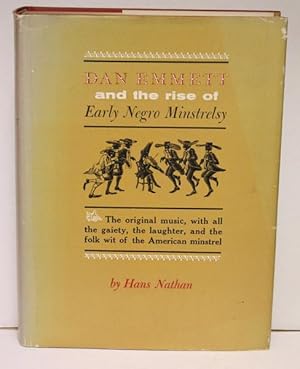NATHAN, HANS; EMMETT, DANIEL DECATUR (1 Ergebnisse)
Produktart
- Alle Produktarten
- Bücher (1)
- Magazine & Zeitschriften
- Comics
- Noten
- Kunst, Grafik & Poster
- Fotografien
- Karten
-
Manuskripte &
Papierantiquitäten
Zustand
- Alle
- Neu
- Antiquarisch/Gebraucht
Einband
- alle Einbände
- Hardcover
- Softcover
Weitere Eigenschaften
- Erstausgabe
- Signiert
- Schutzumschlag
- Angebotsfoto
- Kein Print-on-Demand
Land des Verkäufers
Verkäuferbewertung
-
Dan Emmett and the Rise of Early Negro Minstrelsy.
Verlag: University of Oklahoma Press, Norman, Ok., 1962
Erstausgabe Signiert
Cloth. Zustand: Very Good. Zustand des Schutzumschlags: Good. First Edition, xiv, 496 pp. [Including a selection from the works of Dan Emmett and others. With illustrations, including portraits and musical illustrations, and with a bibliography.] Small chips and tears to the edges, sunning to the dust jacket, book very good or better. Inscribed to Saul Novack, musicologist, by the author. From the jacket copy--''The blackface theater that flourished in nineteenth-century America had roots had roots extending across the Atlantic to the England of the late seventeenth century, when writers, poets, dramatists, and musicians were composing a literature of sympathy and protest against the perversity of the slave trade. In America the initial and tentative stages of Negro impersonation and song came between 1815 and 1830 with the creation of two 'Negro stage characters'--one, the southern plantation hand, the other, the ludicrous black replica of the white dandy of Main Street. // By the late thirties Daniel Decatur Emmett--banjoist, fiddler, sing, comedian, composer, and writer of lyrics, stump speeches, and plays--had arrived on the minstrel scene. His first song was sung at the Cincinnati Circus in 1838, and nearly twenty years later he wrote was has since become the most popular song in America--the immortal ''Dixie.'' This book is a first, combining history, biography, musicology, and bringing to the public a piece of long-needed Americana, including the early songs, lyrics, and dances of minstrelsy. Together with the southern folk hymn, the music of the minstrel theater represents the most typically American music of the past century.''. Inscribed by Author(s).


